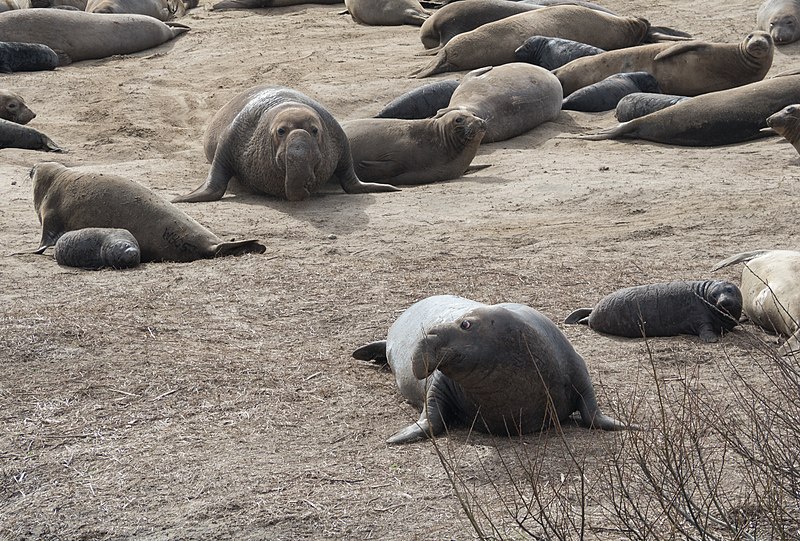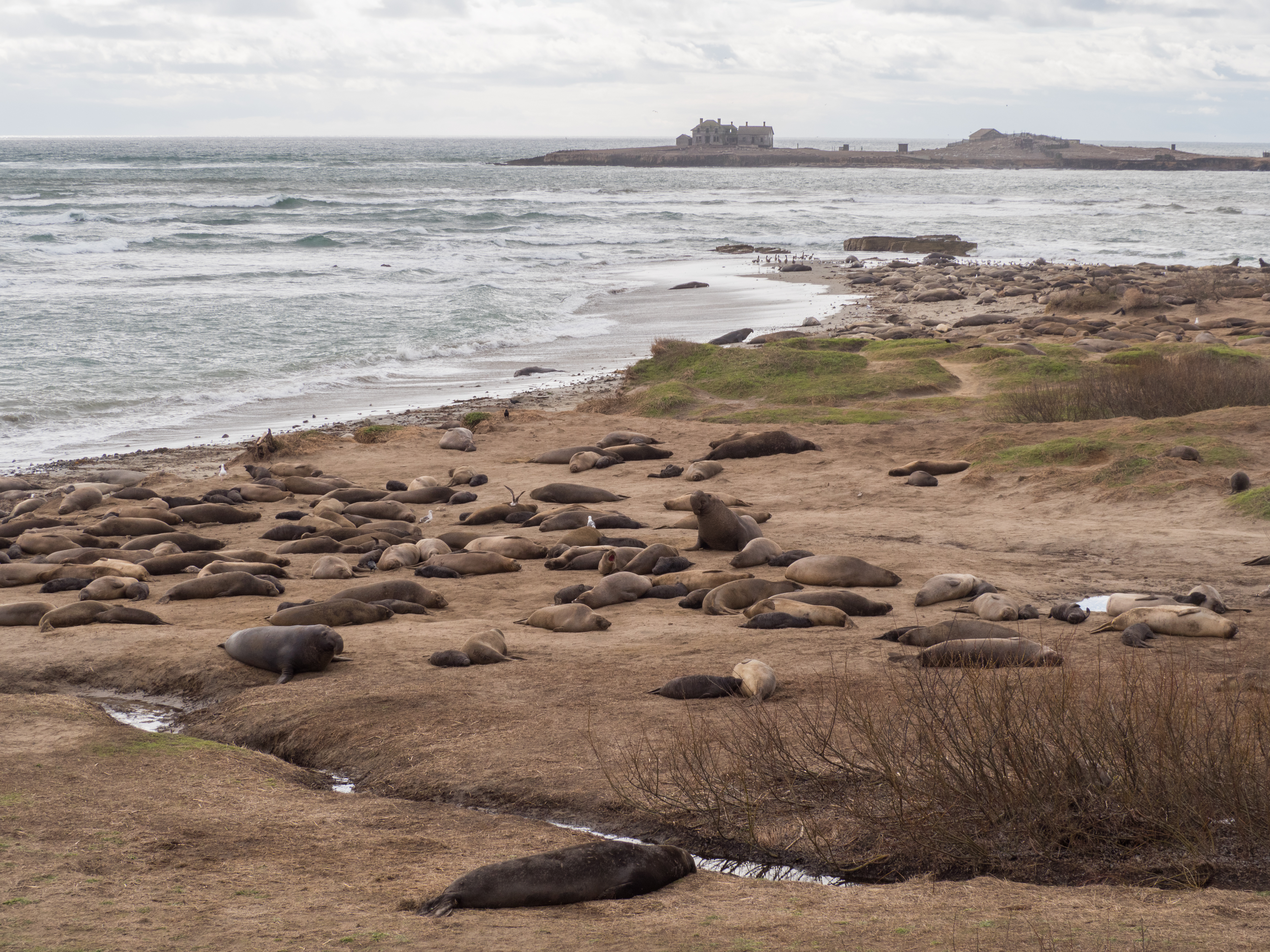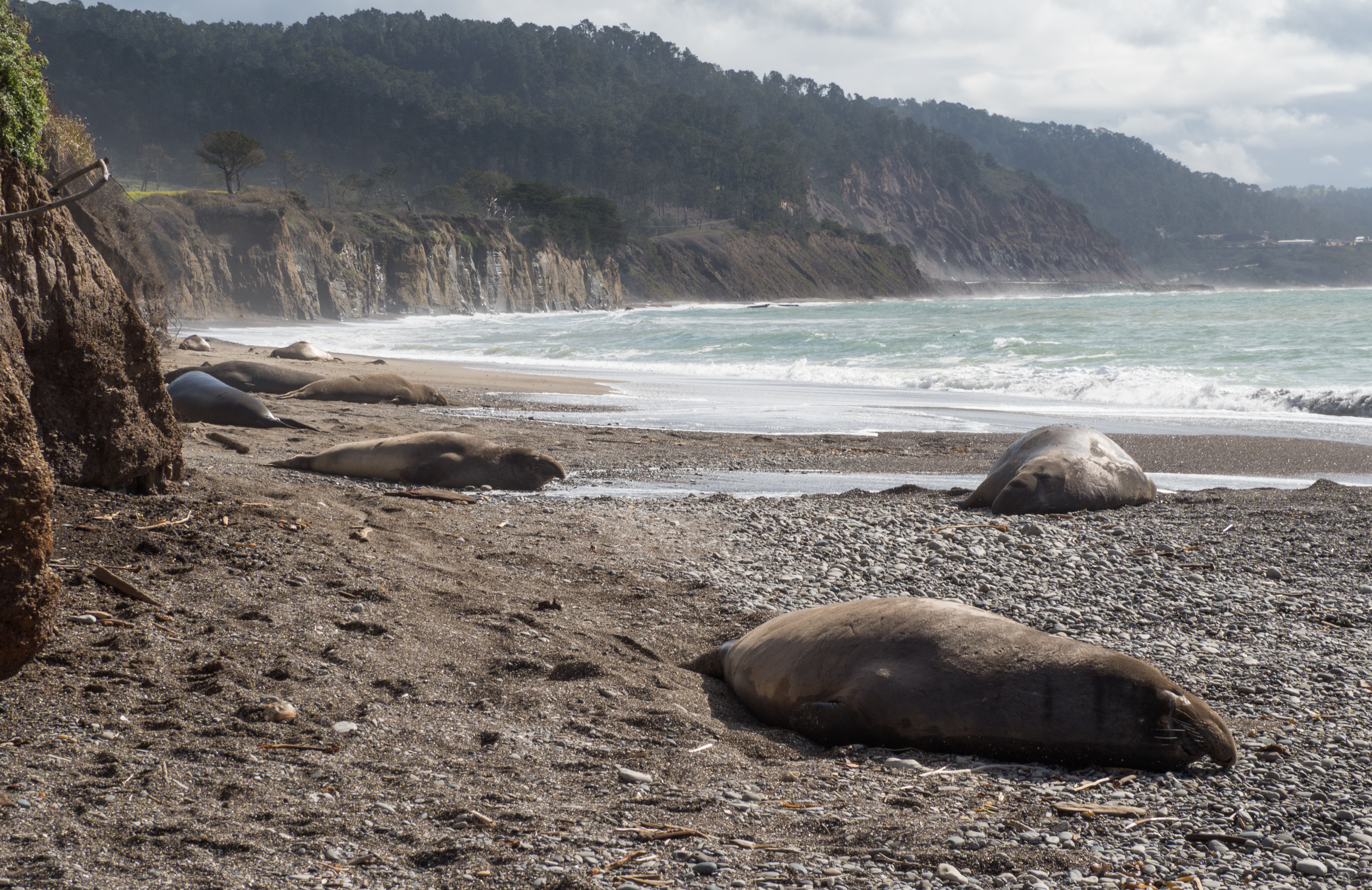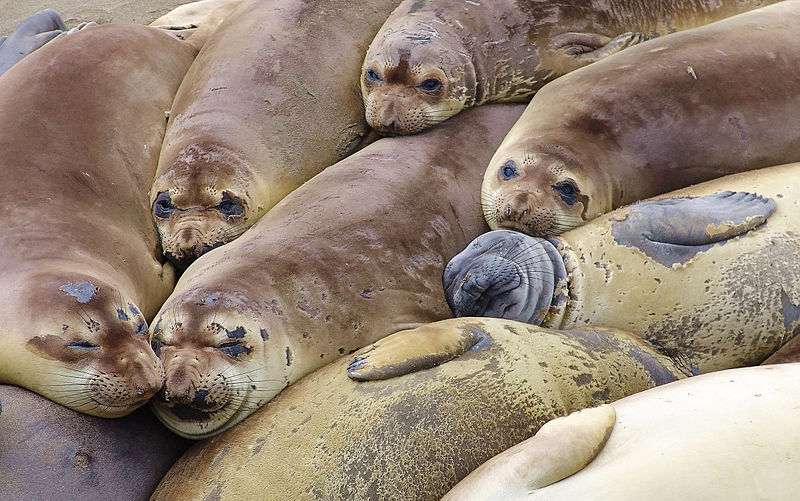Elephant seals at Año Nuevo State Park | Photo by Rhododendrites, Creative Commons, Wikimedia Commons
| FEATURED
By Kat McGowan
Courtesy Bay Nature Magazine
On a sparkling blue January morning, I meet marine biologist Patrick Robinson, who will escort me around Año Nuevo State Park, a patch of dunes and bluffs just north of Santa Cruz. As we start along a sandy path toward the beach, he explains that his role is not only to protect me from the thousands of elephant seals currently camped out here, but to protect the elephant seals from me. That sounds sensible enough — until we come over a rise and I see what they actually look like in the flesh.
Blocking the path is a massive blob of quivering blubber, braying like a donkey. This hunk of chonk, the size and shape of Jabba the Hutt, is a male northern elephant seal. He might weigh as much as 4,500 pounds, and he can flop his jiggly body across the sand as fast as we can run. Robinson warns me to watch where I walk, and to be careful not to invade any seal’s personal space. I make eye contact with Jabba, who watches us with mild curiosity, his dark eyes lustrous over the dangling snoot that gives the species its name. I am not even slightly tempted to get closer.
A few hundred yards more down the path there are seals everywhere, lolling and scratching. We weave among them, trying not to get too close. But every rounded dune comes alive as a seal back or flank; what looks like driftwood sighs deeply and twitches a flipper. There are just so many of them. Like clockwork every winter, more than 2,000 adults congregate on these shores for their annual sealapalooza of fighting, birthing, nursing, mating — all of life’s main events in just a few months. Sort of like “Jersey Shore,” but for seals.
While the males battle for breeding rights and the females nurse their newborn pups, none of the adults eat or drink, losing more than 30 percent of their body weight. This ultra-endurance event is just one of the many extraordinary things elephant seals do. “When they come together in space and time, everything is very extreme,” says behavioral ecologist Colleen Reichmuth of the Institute of Marine Sciences at University of California Santa Cruz. “The level of competition is extreme, the level of risk is extreme. These animals are fasting, with no food and water, so the physiological constraints are extreme.”
Blocking the path is a massive blob of quivering blubber, braying like a donkey. This hunk of chonk, the size and shape of Jabba the Hutt, is a male northern elephant seal.
Because it is both amazing and convenient to study, the northern elephant seal, which ranges throughout the North Pacific, is one of the best-measured of all marine mammals. Over the years, using harnesses and marine glue, straps and cattle-ear-tag guns, scientists have attached all sorts of gizmos to the creatures’ mighty heads and shoulders — cameras, GPS tags, depth sensors, heartbeat monitors — to measure where they’re going and what they’re doing way out there in the ocean.
“Every time we turned around, we’d uncover some really cool fact or observation,” says UCSC evolutionary biologist Daniel Costa, who first began studying these mammals in the mid-’70s and now supervises all Año Nuevo elephant seal research.
Scientists here and elsewhere learned that elephant seals dive deeper (nearly 6,000 feet), swim farther (averaging more than 9,000 miles a year), and hold their breath longer (up to two hours) than any other seal. Only their cousins, the southern elephant seals, can hold their breath for as long as they can—up to two hours. (Harbor seals, by comparison, can hold their breath just a half hour and go no deeper than 1,500 feet.) Males are more than three times the size of females, one of the biggest sex-based size differences among mammals. They aren’t just polygamous, but maybe the most polygamous of mammals, forming harems in which one male might mate with up to 100 females.
Enlarge

The extraordinary nature of this animal has already forced scientists to question the supposed limits of mammal physiology. These deep-diving, breath-holding, long-fasting creatures are closely related to other marine mammals that can’t pull off such feats. The implication is that minor tweaks to mammal biology can translate to huge differences in ability. Elephant seals may even teach us how our own bodies function and what we might be capable of.
For now, though, the question that preoccupies the scientists of Año Nuevo is what will happen to the animals in a warming world. Climate change is poised to disrupt everything in the ocean in coming decades, from ocean currents to the location of the most and best fish. A new wave of research projects here probe whether these unusual mammals are resilient enough to keep thriving—whether they will be extraordinary enough to cope with the huge changes heading their way.
The sands of Año Nuevo were not always jammed with dozing seals. In the late 1880s, the northern elephant seal was thought to be extinct, decimated by blubber-hunters, until some naturalists found a tiny band of holdouts on an island off Mexico—and promptly killed most of them to take them home as specimens.
But elephant seals are nothing if not gritty, and a few survivors held on, slowly rebuilding their numbers. By the 1970s the seals began pupping and breeding at Año Nuevo, just 30 minutes’ drive north of UC Santa Cruz and its world-class marine biology department. That proximity was a lucky stroke for researchers: The animals tolerate the humans who tiptoe amongst them. And as biological outliers, they offer a singular chance to study the outer fringes of mammalian performance.
The portly creatures that Robinson and I sneak past don’t look like stupendous athletes. Yet for up to eight months of the year, they roam the remote eastern and central North Pacific, plunging way below the surface on nearly continuous foraging dives. Blubber analysis conducted by Chandra Goetsch in Costa’s lab indicates they eat deepwater prey like lanternfish, squid, and viperfish, and they eat a lot of it. In roughly seven months of migration, female seals gain an average of nearly 600 pounds, which can mean they nearly double their body weight.
As they dive, their hearts slow to below five beats a minute while blood flow to the muscles shuts off — a trick that interests anesthesiologists who would like to stop circulation to a body part during surgery, then restart the flow without damage. Elephant seals can also surface from marathon dives to breathe for less than five minutes, then dive again. “There’s a lot we don’t understand about how they do that,” says behavioral ecologist Birgitte McDonald of Moss Landing Marine Laboratories. The behavior seems to break physiological rules: If a Weddell seal, for instance, dives for more than 20 minutes, it uses up all its oxygen. Its muscles start dumping lactate into its blood, and the seal must breathe for 90 minutes or more before diving again.
The fact that these seals wander so widely, dive so deep, and reliably return to Año Nuevo means they can also be employed as sensors to probe parts of the ocean that are difficult or expensive to measure. One student in Costa’s lab recently explored using data gathered by fluorescence meters attached to the seals to cheaply chart chlorophyll levels out in the North Pacific, measuring that all-important first link of the food chain — the phytoplankton and algae that ultimately feed everything else in the ocean, from baby fish to blue whales, and which indirectly reflect how windy or warm ocean conditions are.
Robinson and I reach our first destination: an observation deck overlooking Bight Beach, where roughly 75 northern elephant seals sprawl in the sun, females honking and rasping, their chocolate-brown pups beside them mewling and trilling. There’s just one enormous male down near the water, keeping watch. It looks like a day spa with a really scary bouncer.
Enlarge

He looks tense, for good reason. The privilege of breeding is reserved for just a few dominant males like him; 99 percent of elephant seal males never mate. This guy vanquished the competition, but the also-rans just won’t stop trying. Elephant seal combat can be brutal: the bulls square off, rear up, then smash their chests together, rassling and shoving and gashing at one another’s shoulders and flanks with their teeth, leaving each other raw and bloody.
Even now, a male with a big glob of dried blood on his shoulder lurks at the top of the cove. Chances are, Scary Bouncer Seal caught him trying to get with his ladies and taught him a lesson. But although it is spectacular, bull vs. bull is rare, because it is just too draining.
Reichmuth and her former graduate student Caroline Casey discovered a few years ago that the big brutes prefer to roar at each other rather than waste their energy on physical attack.
Here at this beach, the variety of sounds is indescribable, although I try: “Asthmatic lion,” I scribble in my notebook. “Old outboard motor. Gargling drain. Strangling a Pomeranian.”
Above it all rises the long, throbbing snort-roar of that big guy near the water. (Bonus elephant seal freak fact: They are among the loudest of any land mammal.)
To understand what those calls mean and how they relate to breeding success, Reichmuth and Casey first mapped the bull hierarchy. They filmed confrontations between tagged males, recording the outcome of each standoff or fight. Because not all bulls fight one another directly, and because she couldn’t track every last conflict, Casey used a method borrowed from competitive chess called the Elo system to assign each bull a comparative rank.
Next, they recorded each male’s voice and did playback experiments. The seals evidently understood the bellows: Middle-status males charged toward the speaker when they heard recorded calls of low-ranking bulls, but those same mid-rank guys fled from sounds made by alpha males. “We were like, ‘What is going on here? What are they saying to each other?’” Casey says. “We wanted to decode the language of male elephant seals.”
Top males did not have lower voices or longer calls or share any other obvious characteristic. What Casey’s analysis showed instead is that each male’s voice is distinctive and stays the same from year to year. The kicker: When she drove up to Point Reyes National Seashore and played her Año Nuevo recordings to the elephant seal colony there, the bulls didn’t react either way.
Her interpretation is the bulls recognize the voices of bulls they’ve met and keep a mental ledger of whom they’ve fought and who won, so as to avoid unnecessary and exhausting rematches. “It’s amazing,” she says. “It means that they have really good memory, and are able to manage and remember a lot of unique calls.” It’s also an effective conflict-avoidance strategy: in three-quarters of confrontations, she found, one of the males backs down before things get violent. In a species famed for aggression, there’s actually way more talk than action.
Enlarge

While the bulls bluster and brawl, elephant seal females endure their own physiological marathon. Without eating or drinking, a mother produces nine pounds of milk per day during the roughly four weeks she nurses her pup. The rich milk fattens the pup, preparing it to survive alone on the beach for months after the mother returns to the sea.
Mother seals draw on their own fat reserves to do this, so it’s essential they arrive here at a healthy weight. The researchers at Año Nuevo are careful not to disturb the animals too often or for too long, particularly mother-pup pairs. So to track their health, Robinson is developing creative ways to weigh them without disturbing them, such as using drones that estimate their size with photography.
Today we’re hoping to “weigh” seal #9454, one of two dozen females who has been carrying a satellite tag that tracked her path through the Pacific. Robinson plans to link her route to her weight for a multidimensional view of where and how well she ate.
We spot her among a dozen other mothers, her chin propped on her plump days-old pup. The small satellite device epoxyed to her head gives her an aristocratic, eccentric look, like a drunken duchess at a garden party. As Robinson’s drone hums above her, snapping pictures, she regally ignores it.
Enlarge

Weighing her unobtrusively is important because her reproductive success requires her to conserve her energy. All mothers move around, jockeying for space on the beach and warding off intrusive males. But much of a mother’s energy goes into milk. When pups are first born, McDonald found, mothers produce milk that’s 20 percent fat, skyrocketing to nearly 60 percent right before weaning. (By comparison, cow’s milk is only about 4 percent fat.) Despite the physical toll of producing milk while also fasting, elephant seal mothers will sometimes nurse both their own pup and an orphaned one—an effort doomed to fail.
“To nurse a pup that’s not your own, that’s really difficult to explain, given what we know about elephant seals,” says Reichmuth’s postdoctoral student Juliette Linossier.
One possibility is that the mothers just don’t notice the difference. But that doesn’t seem to be the case, Linossier has found. She shows me a video from last winter, in which she plays a recording of calls made by a random stranger pup to a seal mother, who barely reacts. But in response to a recording of sounds from her own pup, the mother snaps her head up and whips around to stare at the source. She flops a foot or two toward the speaker, clucking and barking and swiveling her head in search of her baby, which is actually right beside her.
Linossier is trying out scent-recognition tests too, using a fake pup fashioned from old wetsuits. To imbue her model with eau de pup, she creeps up on a sleeping baby and rubs it with a towel so gently that it doesn’t wake up. She then attaches the towel to the neoprene suit and places it near the mother. (How does a baby elephant seal smell? “Worse than a dog,” Linossier reports.)
It’s painstaking, slow-moving research, because she must be careful not to upset the seals — both for the animals’ sake and in order to truly understand mother-pup interactions. Linossier has yet to analyze her data, but what she’s seen so far suggests that seals hear and maybe even smell the difference between their own and another mother’s pup. If nursing a strange pup is no dumb mistake, one possible explanation lies in the genes. Since one male can sire dozens of pups each year, many of the seals on the beach are related, and the mothers may be actually feeding distant kin. Linossier’s next plan: genetic tests to determine relatedness.
The northern elephant seal population now numbers about 150,000 and is spreading north. The seals normally molt on California beaches, but last summer, two elephant seals from Southern California were spotted onshore in Alaska, where they’ve almost never been seen before. It’s a hopeful sign. Maybe they will be able to seize new opportunities—an essential skill in an era when climate change may transform everything these animals know.
Elephant seals seem to be creatures of habit, returning to the same spots to feed and to breed every year. In a changing world, that faithful tendency could become a problem. Their preferred pupping grounds may get swamped by rising seas. The beaches where they haul out to molt may get too hot. And in the future, as waters warm and currents shift, their favorite foraging spots may no longer provide fish by the ton. During El Niño years when the central Pacific becomes warmer than usual, the seals have had trouble finding food—possibly a preview of what’s to come.
“Are they too preprogrammed to adapt, or are they flexible enough to say, ‘This space isn’t working out, I’ll go somewhere else’?” asks graduate student Rachel Holser, whose research focuses on decision-making. To investigate this question, she can’t interfere with the seals’ fishing grounds or experimentally warm the water the creatures swim in. Instead, she uses a type of experiment common in behavior research: measuring an animal’s response to something it’s never seen before to determine how risk-averse it is. Its responses tend to be consistent across different situations: A bold animal will probably be more willing to explore new places; one that flees from an unfamiliar object will tend to stick with what it knows.
For the test, she stripped a radio-controlled toy truck down to its chassis, outfitting it with a speaker and a GoPro video camera. Then she loaded it up with a recording of the T. rex roar from Jurassic Park. (Alternative experimental stimulus: the screech of Godzilla.)
At her desk in the Institute of Marine Sciences in Santa Cruz, she shows me video of the experiment. The GoPro image jolts and shudders as the tricked-out car crawls across the beach toward a cluster of seals. It halts roughly 10 feet from a female, who stares into the camera and grunts.
A few minutes later, we hear the bellow of T. rex, and all six seals pivot toward the camera. Holser says this is about as big a reaction as she gets out of most seals, who quickly lose interest in the contraption. That female with the death stare, however, is one of the exceptions. Another dinosaur roar, and she charges right at the camera, pink mouth gaping wide, grunting angrily—the video captures her whole palate vibrating as she barks.
After decades of research, Año Nuevo scientists have a pretty good idea of how much disturbance the animals can tolerate without lasting effects. They carefully weigh any potential impact on fitness, like the energy wasted on confronting a radio-controlled gizmo, against the gain of better understanding—in this case, how this seal and her kin might deal with other unexpected situations. The majority of animals return to normal behavior within two to five minutes, Holser says, and this seal is no exception. While she’s clearly not thrilled about the interruption, the whole drama blows over very quickly.
Holser must still analyze these data, but you don’t need to be a scientist to grasp that this particular seal has little fear of the unknown. What’s less clear is what that implies about her future, that of her pups, and, really, of the whole colony at Año Nuevo. “Is an aggressive female a better mom, because she protects her pup, or is she worse because she’s running around the beach wasting her energy?” says Holser. “We don’t know what the answer is.”
On the screen, the seal grunts one more time, then backs off with a last dirty look. And then this extraordinary animal—this exceptional survivor, this rule-breaker among mammals, this fearless challenger of unexpected scientific thingamajigs—lays her head back down on the sand and drifts back to sleep.
Kat McGowan is a journalist and editor based in Berkeley and New York City.
Have something to say about this story? Send us a letter.